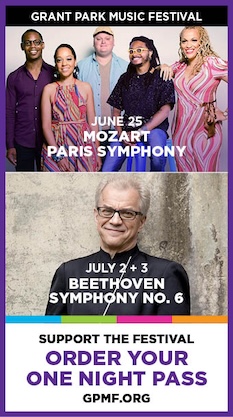Webern’s concise music given sterling advocacy by Robertson, Civic Orchestra

Anton Webern’s music seems to be suffering a paradoxical fate. With its surfeit of ideas and peerless concision, the Austrian’s compact oeuvre is often considered the perfect representation–and even the fulfillment–of the Second Viennese School. And yet there are relatively few concert performances of it, compared to his more visible companions in Schoenberg and Berg. Here is important music nobody hears.
So when the Civic Orchestra of Chicago presented three works on Sunday afternoon at Orchestra Hall, it was as if a mini-Webern festival had come to town. Under the baton of David Robertson and the supervision of Pierre Boulez—one of Webern’s greatest champions—the event carried with it an authoritative gravitas of which future generations will be deprived.
“We are still behind the times,” said Boulez during a breezy and engaging on-stage Q&A with Robertson Sunday afternoon. Boulez, who is celebrating his imminent 85th birthday with the Chicago Symphony this month, was referring to how the music-going public still reluctantly embraces this already century-old music. Previously, Boulez has said standard repertoire should be used to expose audiences to contemporary music, and it was clear Boulez has little hope for luring conservative audiences in, say 2110, with the music of Webern.
The Passacaglia Op. 1, written in 1908 as an academic thesis, is certainly one of the composer’s most approachable works. It best illustrates Webern’s affections for Mahler even though he would later learn to repress them as he matured. All the wailing melodic lines soared and Robertson set his strings free. Here is where Webern and Berg were virtually stylistically inseparable.
The more distinctive Five Pieces for Orchestra, Op. 10 (1911-1913) is a micro-opus with each piece lasting around a minute. Webern discovers the most unusual colorful combinations: Mandolin and guitar provide a futuristic twang as other regions of the orchestra twitch eerily with sound. Celesta and violin work in close accord, giving off the effect of a musical airplane propeller. The Civic Orchestra delivered each little surprise like period specialists.
Perhaps the most revered creation of Webern’s is the Six Pieces for Orchestra, Op. 6 (1909), whose larger-scale form fits more comfortably on traditional programs. Robertson found fervent expression in each nomadic little movement and the unearthly funeral march exploded with volcanic sound.
Appending the Adagio from Mahler’s uncompleted Tenth Symphony to the program made perfect sense. Once the gorgeous opening theme subsides, a middle section arrives, replete with tonal oddities and instrumental surprises, a la Webern. The bold voicing from the French horns was masterly although the cellos were less coherent. Robertson opted for a decidedly modern flavor with a brisk voyage that was low on tragic drama. This certainly wasn’t Bernstein’s Mahler, but, with Pierre Boulez on the premises, it shouldn’t have been any other way.
Posted in Performances

